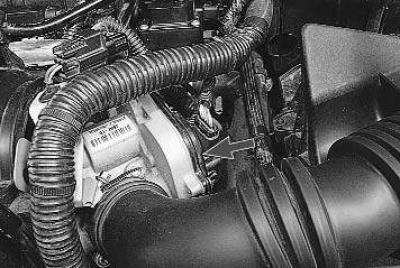Conventionally, three types of jerks can be distinguished:
- at the moment of the beginning of the movement;
- during acceleration;
- with steady motion, i.e. at a constant position of the accelerator pedal.
To determine the causes of jerks when driving a car with an injection engine, special diagnostic equipment is required, so we recommend that you contact a car service that specializes in repairing fuel injection systems. However, as practice shows, in most cases, jerks are caused by insufficient fuel pressure in the fuel rail or a malfunction of the throttle position sensor built into the throttle assembly cover. In addition, a specific cause of jerking in a Ford Fusion equipped with an electronic throttle control system may be a malfunction of the accelerator pedal.
With some skills, the cause of jerks can be identified independently.
Jerk at the moment of the beginning of the movement
At the moment of the beginning of the movement, there is more often an extreme case of a jerk - a failure. The most unpleasant sensations are associated precisely with the delay in the engine's response to pressing the accelerator pedal. Sometimes the engine even stalls.
A jerk occurs at the moment the throttle valve opens, when, according to the signal from the throttle position sensor, the ECU determines the moment of transition from idle to load mode and must increase the amount of fuel supplied through the nozzles. With insufficient pressure in the fuel rail, even with an increase in the duration of injection, there is not enough fuel for a smooth start. For the procedure for checking fuel pressure, see subsection «Checking fuel pressure in the power system».
In addition, a jerk can also occur due to a malfunction of the electromechanical part of the throttle assembly and contamination of the throttle valve with deposits from crankcase gases.
Jerks during acceleration
The cause of jerks during acceleration can be, as in the previous case, insufficient fuel pressure in the fuel rail. The electronic engine control unit, having received a signal from the throttle position sensor about the intensive opening of the damper at a large angle, seeks to maximize the fuel supply, but due to the reduced fuel pressure it is not able to do this. The reasons for this phenomenon and the method of verification, see subsection «Jerk at the moment of the beginning of the movement».
In addition to these reasons, jerks during acceleration of a car with an automatic transmission can be caused both by an insufficient amount of working fluid in the box, and by a malfunction of the box itself.
Note. An automatic transmission vehicle may experience jerky acceleration at the start of the first trip after disconnecting and reconnecting the battery. This is not a malfunction, because after several accelerations, the electronic unit will calibrate the gearbox control and the gear shift will become smooth.
Jerks in steady motion
Such jerks are most often caused by a malfunction of the ignition system. Diagnosis and repair needed (see sect. 10 «electrical equipment»). On the way, you can try to do the following yourself:
- carefully inspect the underhood space. Switch off the ignition and check the reliability of fastening and landing of all wires and connectors at the ignition coil and high-voltage wires. Start the engine and listen to its work: crackling during the breakdown of high voltage current on «mass» weak but distinct. In complete darkness, a spark is clearly visible during breakdown;
- replace spark plugs regardless of their condition and mileage. Pay attention to the condition of the candles: if it is not up to standard, it may be necessary to repair the engine or its systems.

A specific cause of jerks in the steady motion of a Ford Fusion may be a failure of the throttle position sensor built into the throttle assembly cover.
Additional symptoms confirming the malfunction of this sensor:
- uneven engine idling;
- reduction in maximum engine power.
The throttle assembly cover is non-separable, so it is not repairable. If a sensor malfunction is detected (see «Check and replacement of gauges of a control system of the engine»), replace the throttle assembly with cover.
Visitor comments